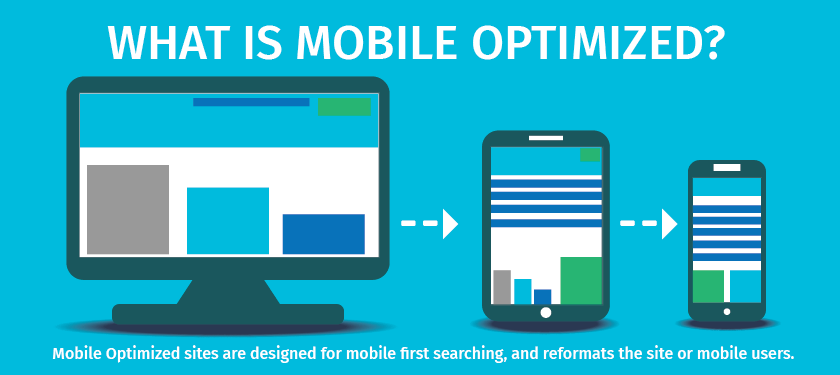
The Ultimate Guide to Mobile Optimization: Methods for Enhancing Web Site Performance on Smartphones and Tablets
The approaches for boosting web site performance on mobile systems go past mere adjustment; they include a detailed technique that involves receptive style, speed optimization, web content methods, and individual experience improvements. By delving into the ins and outs of mobile optimization, companies can not just satisfy user assumptions but additionally stay in advance in a competitive electronic landscape.
Significance of Mobile Optimization
Mobile optimization plays a pivotal function in enhancing individual experience and driving conversion rates in the ever-evolving electronic landscape. With the increasing use smart devices and tablet computers for searching the internet, ensuring that web sites are optimized for mobile phones has actually become imperative for businesses - Mobile Optimization. A mobile-optimized internet site not just adapts flawlessly to different display dimensions but likewise lots rapidly, supplying users with a smooth and satisfying surfing experience
In today's fast-paced world, individuals anticipate instant access to info on the move. A website that is not enhanced for mobile tools threats losing potential clients because of reduce filling times or a poor interface. By investing in mobile optimization, services can deal with the demands of their mobile target market, leading to higher engagement and enhanced conversions.
Additionally, internet search engine like Google focus on mobile-friendly websites in their rankings, making mobile optimization vital for boosting presence and bring in natural web traffic. Mobile Optimization. On the whole, the relevance of mobile optimization can not be overemphasized, as it straight affects individual fulfillment, conversion prices, and general service success in the electronic realm
Responsive Layout Techniques
Applying responsive layout techniques makes certain that web sites dynamically adjust their design and web content based on the customer's device display dimension, offering a regular user experience throughout various platforms. Among one of the most typical approaches used in responsive style is creating fluid grids that enable web content to resize proportionally to the screen size. This makes certain that elements on the website keep their relative spacing and plan, enhancing the watching experience for users on different gadgets.
In addition, making use of flexible pictures that can scale with the size of the viewport assists protect against images from being cropped or distorted on smaller screens. CSS media inquiries play a crucial role in responsive style by enabling designers to use details designs based upon the tool qualities such as screen width, height, and positioning. By leveraging media queries, internet sites can adjust their format and design to suit mobile phones, tablets, and desktop screens perfectly.
Integrating responsive design techniques not only enhances customer experience yet additionally adds to boosted internet search engine positions, as internet search engine like Google focus on mobile-friendly web sites in their mobile search engine result. By accepting responsive design, internet sites can accommodate the varied requirements of users accessing web content visit site on a selection of gadgets, eventually driving engagement and conversions.
Speed and Efficiency Optimization

One secret method is optimizing images and multimedia web content to minimize data sizes without endangering top quality. Pressing photos, leveraging contemporary picture formats like WebP, and careless packing offscreen my sources images work techniques to speed up lots times (Mobile Optimization). Decreasing HTTP requests, leveraging web browser caching, and minimizing web server feedback times are important steps in improving performance.
Carrying out a content shipment network (CDN) can additionally substantially boost web site speed by distributing web content across several web servers worldwide, lowering latency for users accessing the website from various locations. Prioritizing critical above-the-fold material and postponing non-essential manuscripts can even more boost regarded performance. By concentrating on rate and efficiency optimization, websites can provide a smooth and enjoyable user experience on mobile gadgets.
Mobile-Friendly Web Content Strategies
Mobile-friendly material techniques involve customizing the discussion of info to fit the smaller displays and on-the-go nature of mobile phone and tablet users. In addition, damaging up material into much shorter paragraphs and making use of bullet points can help boost readability and make it much easier for individuals to consume details swiftly.
Integrating engaging visuals, such as photos and videos optimized for mobile watching, can likewise enhance the overall customer experience. These visuals must be appropriate, high-grade, and lots quickly to protect against individuals from losing passion. Incorporating interactive aspects like tests, polls, or surveys can enhance individual engagement and motivate energetic participation.
Individual Experience Enhancements
Building on the foundation of mobile-friendly web content techniques, boosting user experience involves maximizing every touchpoint to ensure smooth communication and fulfillment for mobile customers. One important facet of enhancing individual experience on mobile tools is guaranteeing quickly filling times. Users expect web sites to fill quickly on their mobile phones and tablet computers, and any kind of hold-ups can lead to irritation and increased bounce rates. Executing responsive style is an additional key element in enhancing individual experience. Receptive layout makes certain that websites adapt to various screen sizes and resolutions, providing a constant and easy to use experience across different devices.
In addition to speed up and receptive design, simplifying navigating is crucial for a favorable user experience. Clear and intuitive navigating food selections, popular search bars, and strategically placed call-to-action switches can aid individuals quickly find what they Full Report are seeking on a mobile site. Enhancing forms for mobile customers by reducing the number of areas and utilizing auto-fill attributes can likewise enhance the general user experience. By concentrating on these individual experience improvements, web sites can efficiently involve and keep mobile site visitors.
Verdict
In conclusion, mobile optimization is critical for enhancing web site efficiency on smartphones and tablet computers. By executing receptive design methods, maximizing speed and performance, developing mobile-friendly web content, and enhancing individual experience, organizations can effectively reach and engage with their mobile target market. It is crucial for sites to adapt to the boosting mobile use fads in order to remain competitive in the digital landscape.